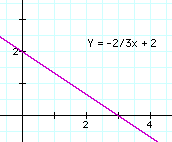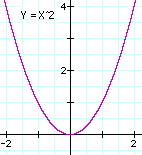|
(11) Graphs and Ellipses
|
to Galileo Kepler's Laws (For teachers) and First Law Newtonian Mechanics |
The laws of orbital motion are mathematical, and one cannot explore them without some mathematics. The math used here is rather elementary; if you need to refresh your familiarity with it, click here. You can also skip the equations and follow the narrative only. The Mathematical Description of a CurveAs already noted, the cartesian system labels any point in a plane (e. g. on a flat sheet of paper) by a pair of numbers (x,y), its distance from two perpendicular axes. These numbers are known as the "coordinates" of the point. 
A line in the plane--straight or curved--contains many points, each with its own (x,y) coordinates. Often there exists a formula ("equation") which connects x and y: for instance, straight lines have a relationship y = ax + b where any pair of numbers (a,b), positive, negative or zero, gives some straight line. The plot of a line given by one of such relationship (or indeed by any relationship--even pure observation, e.g. temperature against time) is known as a graph. More complicated relationships give graphs that are curves: for instance y = ax2 
gives a parabola, with a any number. Usually (though not always) y is isolated, so that the formula has the form y = f(x) where f(x) stands for "any expression involving x" or in mathematical terms, a "function of x." The curves drawn here are the straight line y = -(2/3)x + 2 and the parabola y = x2. A list of some of their points follows below; if you have paper ruled in squares (as in the images here), mark the points and then try to connect them smoothly, with no sharp bends. |
| Straight line: |
| x | -1 | 0 | 1 | 2 | 3 | 4 |
| y | 8/3 | 2 | 4/3 | 2/3 | 0 | -2/3 |
| Parabola: |
| x | -2 | -1.5 | -1 | -0.5 | 0 | 0.5 | 1 | 1.5 | 2 |
| y | 4 | 2.25 | 1 | 0.25 | 0 | 0.25 | 1 | 2.25 | 4 |
The Equation of a CircleIn the vast majority of formula-generated graphs, the formula is given in the form
Such a form makes it very easy to find points of the graph. All you have to do is choose x, calculate f(x) (= some given expression involving x) and out comes the corresponding value of y. However, any equation involving x and y can be used as the property shared by all points of the graph. The main difference is that with more complicated equations, after x is chosen, finding the corresponding y requires extra work, (and sometimes it is easier to choose y and find x). Perhaps the best-known graph of this kind is a circle of radius R, whose equation is |
|
Draw a circle of radius R centered at the origin O of a system of (x,y) axes . Given any point P on the circle with specified values of (x,y), draw a perpendicular line from P to point A on the x-axis. Then |
|
Here x and/or y may be negative, if they are to the left of the y-axis or below the x-axis, but regardless of sign, x2 and y2 are both always positive. Since the triangle OAP has a 90° angle in it, by the theorem of Pythagoras, for any choice of P, the relation below always holds:
or with the choice of (x,y) coordinates The equation of the circle is satisfied by any point located on it. For instance, if the graph is defined by the equation:
this equation is satisfied by all the points listed below; again, if you can, plot the connecting curve on a sheet of square-ruled paper |
| x | 5 | 4 | 3 | 0 | -3 | -4 | -5 | -4 | -3 | 0 | 3 | 4 | ( 5 ) |
| y | 0 | 3 | 4 | 5 | 4 | 3 | 0 | -3 | -4 | -5 | -4 | -3 | ( 0 ) |
The Equation of an EllipseThe equation of the circle still expresses the same relation if both its sides are divided by R2:
The equation of an ellipse is a small modification of this:
where (a,b) are two given numbers, for example (8,4). What would such a graph look like? Near the x axis, y is very small and the equation comes close to
From which
|
|
|
|
The graph in that neighborhood therefore resembles the section of a circle of radius a, whose equation
also comes close to x2 = a2 in this region. In exactly the same way you can show that near the y-axis, where x is small, the graph cuts the axis at y=±b and its shape there resembles that of a circle of radius b.
An exampleLet us draw the ellipse
We already know that it cuts the axes at x=±8 and at y=±4. Let us now add a few points:
|
|
(1) Choose y = 2 .
Then from the equation
|
|
Substract 1/4 from both sides
Take square roots (marked here by √) and retain an accuracy of 3-4 decimals:
from which x = 6.93 within resonable accuracy.
|
| (2) Choose y = 3 . |
|
Substract 9/16 from both sides
Take square roots (to an accuracy of 3-4 figures):
from which, approximately, x = 5.29 Again, either sign can be attached to x and y. We get 12 points, enough for a crude graph (which you might try to trace on paper): |
| x | 8 | 6.93 | 5.29 | 0 | -5.29 | -6.93 | -8 | --6.93 | -5.29 | 0 | 5.29 | 6.93 | ( 8 ) |
| y | 0 | 2 | 3 | 4 | 3 | 3 | 0 | -2 | -3 | -4 | -3 | -2 | ( 0 ) |
It was a natural extension of the definition of a circle, which is the collection of all points at the same distance (the radius R) from one given point (the center). One point and the distance R defines a circle, two points and the distance R1 + R2 define an ellipse.
Next Stop, for those A Different View of the Ellipse

The collection of all points for
which R1 + R2 has the same value
is an ellipse
The ellipse was already familiar to ancient Greek scientists (known at their time as "philosophers", lovers of wisdom), but they defined it differently.
To them the ellipse was the collection of all points (in a flat plane) for which
the sum of the distances R1 + R2 from two given points was the same (see drawing).
familar with trigonometry-- #11a Ellipses and Kepler's First Law
(If you first wish to learn or review your trigonometry, go to
Trigonometry--what is it good for?
and the sections that follow.)
Timeline Glossary Back to the Master List
Author and Curator: Dr. David P. Stern
Mail to Dr.Stern: stargaze("at" symbol)phy6.org .
Last updated: 10 October 2016
